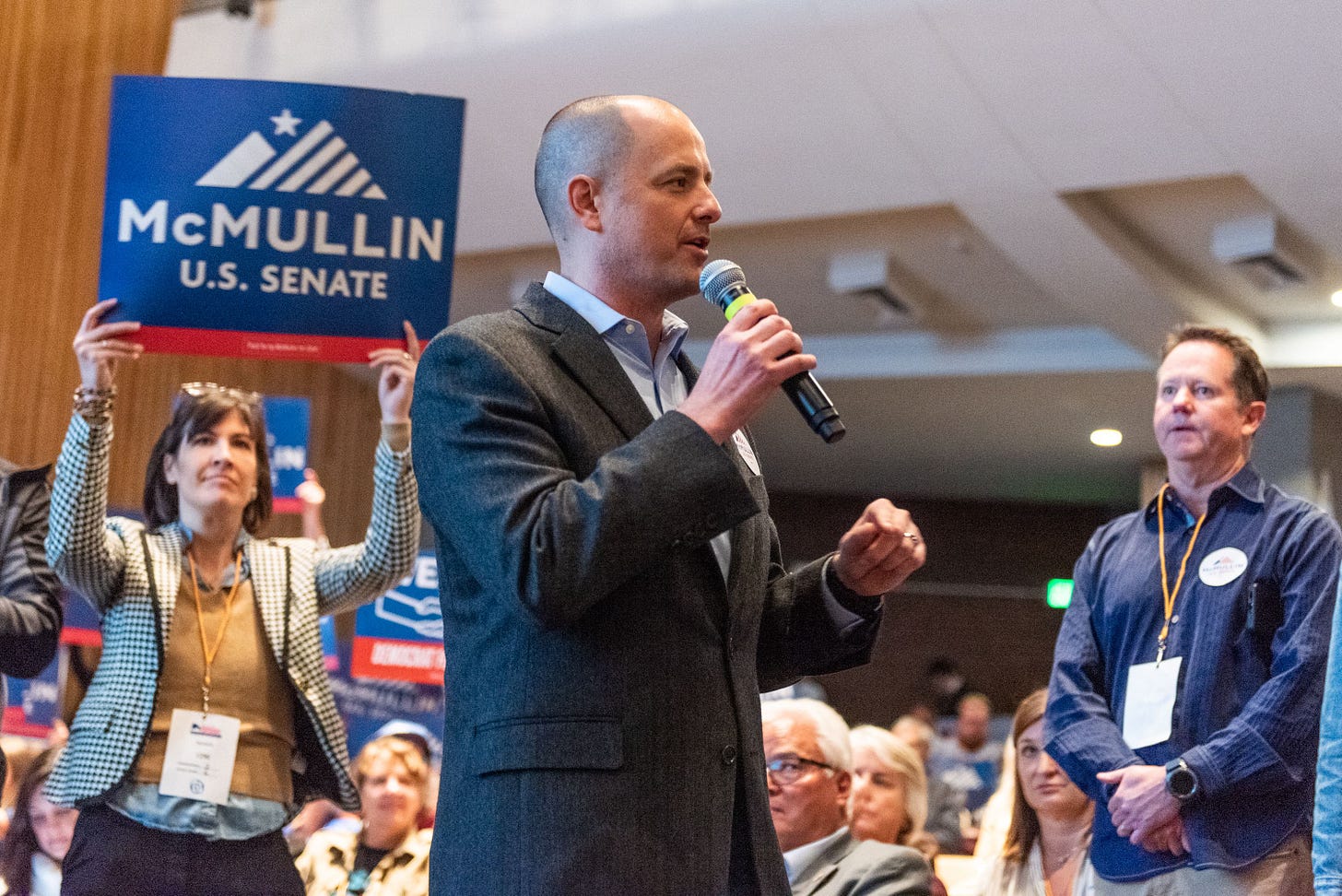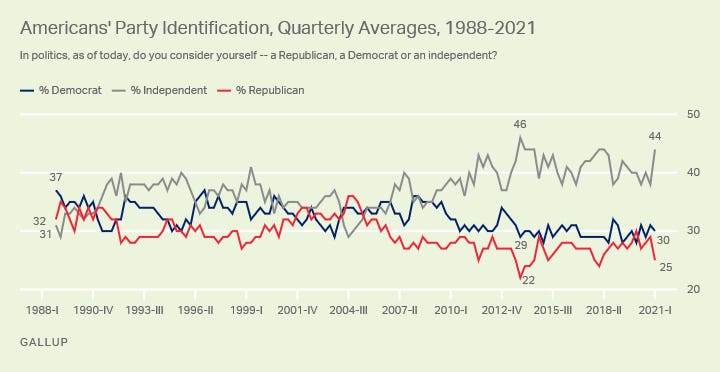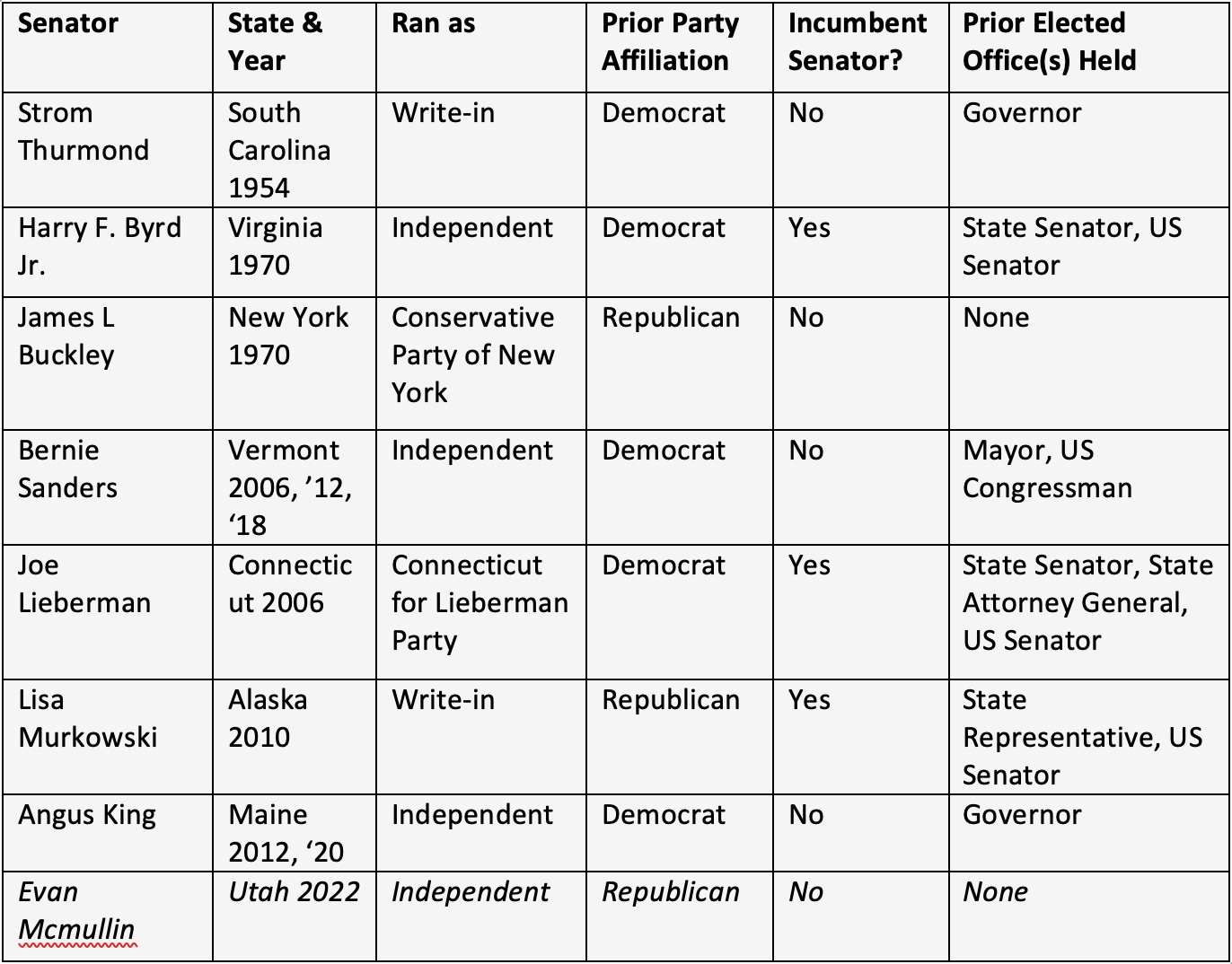Since the dissolution of the Whig Party in the 1850s, and subsequent emergence of Lincoln’s Republican Party, the two-party system has reigned unchallenged in American politics. The relative political stability of the post-World War II Era further entrenched this duality as a seemingly predetermined societal norm. This is the status quo of American politics. But is this inevitable? Are burgeoning whispers of independent political movements and third parties just smoke? Or has the strain of polarization pushed the existing political system to the cusp of a realignment?
This is the first in a multi-part series that explores this very question.
The present national environment has grown unusually favorable for politically independent candidates. In a January 2021 Gallup poll, 50% of American voters surveyed identified as politically unaffiliated. In the more than 40 years that Gallup has polled this question, the number of self-identified independents had never before reached a majority. This unprecedented result is part of a broader trend. In 1988 when Gallup first asked, roughly 30% of Americans identified as independents. That percentage has climbed steadily upward since 1988 and today averages around 45%, with neither major party consistently holding the loyalty of more than 30% of voters.
A two-party system where neither party is particularly popular may present an opportunity for independent candidates to run disruptive campaigns. In the upcoming 2022 midterm elections, the Utah Senate race stands out as a notable example of this moment.
Republican incumbent Mike Lee will not face a Democrat in the general election in Utah. Rather, independent candidate and former Republican Evan McMullin will challenge Senator Lee. McMullin gained national notoriety in 2016 when he ran for President as an independent, garnering a surprisingly strong 22% of the vote in his home state. The former CIA officer and congressional staffer framed his 2016 campaign as an “alternative” for voters in Utah to express their dissatisfaction with Secretary Clinton and then-candidate Trump. This time, McMullin is not planning to be a protest vote. He is running to win.
McMullin’s decision to challenge Senator Lee appears well timed. Lee’s job approval among likely voters in Utah has polled consistently at or below 45% for the past year. Anemic poll numbers do not necessarily spell defeat. Just ask Mitch McConnell, who was polling at 39% in Kentucky less than two weeks before cruising to re-election in 2020. But the data suggests that Senator Lee is on sufficiently unstable ground at home to warrant an electoral challenge.
The McMullin campaign has built a politically diverse coalition of support. The endorsements of national Republicans such as Michael Steele and Adam Kinzinger firmly establish McMullin’s conservative bona fides. High-profile current and former Democrats like Howard Dean and Andrew Yang have also thrown their support behind McMullin. At the local level, the Utah Democratic Party on April 24th voted for the first time in the state party’s history to not field a candidate. They instead endorsed McMullin, a former Republican. McMullin’s unique suite of bipartisan endorsements has already helped attract more than $3 million in direct campaign contributions. Facing an unpopular incumbent with a formidable campaign at his back, Evan McMullin’s independent candidacy appears well equipped to turn heads in Utah in 2022. But will the attention translate into votes on election day?
McMullin’s campaign faces significant historical headwinds. Credible independent or third-party Senate candidates, although unusual, are far from unique. Since the end of World War II, 38 independent or third-party senate campaigns have garnered at least 15% of the vote. Of those 38 candidates, only seven successfully won a senate seat. Of those seven, three – Harry F. Byrd Jr., Joe Lieberman, and Lisa Murkowski – were incumbent Senators who had previously been elected as either Democrats or Republicans, and three others – Strom Thurmond, Bernie Sanders, and Angus King – had previously won multiple statewide elections to other political offices. Only one, James L. Buckley, was elected to the US Senate in 1970 from the state of New York on the Conservative Party ticket with no prior experience in elected office. In 2022, McMullin is seeking to replicate this exceedingly rare feat.
Successful independent Senate runs since 1945:
As stated previously, Gallup polling data suggests that voters in the present national environment feel unusually receptive to independent politics. Unfortunately for McMullin, the American public’s independent streak has not yet translated into meaningful change at the ballot box. Looking at US Senate races specifically, in 1988 only 1.5% of all US senate ballots were cast for independent or third-party candidates. In the four decades since, that number has never been higher than 7% and reached just 4% in 2020. Nearly half of Americans do not strongly identify as either Republicans or Democrats. And yet, greater than 90% of voters consistently cast ballots for candidates belonging to one party or the other.
There are many likely explanations for this asymmetry. Voters who feel a greater sense of party loyalty are more likely to turn out on election day than independent voters. Additionally, although demand for independent candidates may be at a multi-decade high, supply remains scarce. Voters rarely have a credible third option on election day. McMullin’s campaign hopes to address the supply problem by providing a serious independent option for voters in Utah. McMullin’s background, 2016 Presidential campaign, and slate of big-wig endorsements certainly grant him credibility.
But leveraging credibility into a campaign message that builds a winning independent coalition will be the greater challenge. McMullin’s campaign message has thus far painted with broad strokes, casting a traditional conservative tone that aligns with Utah’s red hue while remaining sufficiently abstract on policy so as to not alienate Democratic voters. Although such a big tent approach makes sense in McMullin’s position, it is not yet clear how far McMullin will need to stretch to one side or the other of the political spectrum in order to build a majority coalition. And if the tent becomes too wide, McMullin risks alienating his most loyal supporters.
Thus, the McMullin campaign demonstrates a critical pitfall of the independent lane of American politics. American voters who identify as independents hold a wide range of different political views and are not necessarily neatly grouped together in the political center. Therefore, uniting politically independent American voters into a winning majority coalition is no simple task, even for a centrist candidate. If McMullin cannot find enough independent-minded voters in the political center to win, he may need to expand his reach by appealing to voters to his left or his right. Such a move would be a considerable gamble. A candidate who tries to be everything for everyone risks inspiring no one on election day.
A recent Dan Jones & Associates poll in Utah showed a tight race, with Lee garnering 41% support and McMullin 37%. But with nearly 20% of voters currently undecided, the McMullin campaign faces difficult choices ahead. And the question remains, when presented with a credible third choice, will voters’ frustration with both major parties actually translate into change on election day? Or will the status quo remain steady? Wherever the final tally lands in November, historic intrigue abounds in Utah’s 2022 senate race and the results may tell us a great deal about the state of the two-party system in America.



